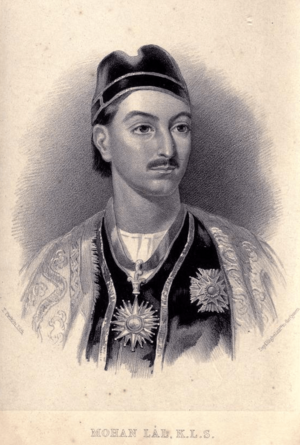Mohan Lal Kashmiri facts for kids
Quick facts for kids
Mohan Lal Kashmiri
KLS
|
|
|---|---|

Photo of Mohan Lal in 1844 by Robert Adamson and David Octavius Hill
|
|
| Born | 1812 |
| Died | 1877 |
| Other names | Ram Nath |
| Occupation | Persian secretary (munshi), traveller and author |
|
Notable work
|
Life of the Amir Dost Mohammed Khan |
| Spouse(s) | Hyderi Begum |
Mohan Lal Zutshi (1812 – 1877), also known as Mohan Lal Kashmiri, was an important Indian traveler, diplomat, and writer. He played a key role in a historical period called the Great Game, which was a rivalry between the British and Russian empires in Central Asia. He was likely the first Indian to be so involved. Mohan Lal also had a central part in the First Anglo-Afghan War (1838–1842). His book about Dost Mohammad Khan, the ruler of Kabul, is a valuable source of information about this war.
Mohan Lal's wife, Hyderi Begum, was a Muslim scholar. During the Indian Rebellion of 1857, she was known for keeping a diary of events in Delhi.
Contents
Early Life and Family Background
Mohan Lal, also called Ram Nath, came from a Zutshi family of Kashmiri Pandits. His great-grandfather, Pandit Mani Ram, held a high position in the Mughal Court. Mohan Lal's father, Rai Brahm Nath, worked for a time with Mountstuart Elphinstone on a special trip to Peshawar. Mohan Lal was one of the first Indian students to study the English curriculum at Delhi College.
His only brother, Kedar Nath Zutshi, worked in Ambala and passed away in 1855.
Adventures with Alexander Burnes
In 1831, a British officer named Sir Alexander Burnes was sent by the British government to gather information in countries between India and the Caspian Sea. He was told to travel as a regular person with a small group, pretending to be poor. Mohan Lal was hired by Burnes mainly to help with his Persian letters. Burnes also believed that Mohan Lal's young age and background would keep him safe from getting involved in local politics. Mohan Lal's official job title was munshi (a secretary), but he preferred to be called "Persian secretary."
Alexander Burnes and Mohan Lal went on an important trip to Central Asia between 1832 and 1834. Their goal was to collect political and military information, and they became close friends during this journey.
Role in the Anglo-Afghan War
Later, Mohan Lal worked for the British as a business agent on the Indus River. He was also a political assistant to Burnes in Kabul during the First Anglo-Afghan War. He saw Burnes being killed by an angry crowd in Kabul at the start of the war. Mohan Lal wrote about this event in his book, Life of Amir Dost Mohammed Khan. He survived the attacks of 1841 and continued to send important updates to Calcutta (the British capital in India) from a merchant's house where he was hiding. His reports often criticized the actions of British officers, especially Sir William Hay Macnaghten and General William Elphinstone.
Mohan Lal had learned Persian in Delhi. He traveled dressed as a Muslim, using names like "Aga Hasan Jan" or "Mirza Quli Kashmiri," in Persia and Afghanistan. He secretly gathered information that was very important for his British bosses.
During the First Anglo-Afghan War, he helped set up and expand the British intelligence network in Afghanistan. He also played a role in weakening the Afghan resistance by helping the British against leaders like Mir Masjidi Khan. He found secret letters from the rulers of Kandahar to Mehrab Khan, the ruler of Kalat. These letters urged Mehrab Khan not to let the British army pass through his land. Mohan Lal gave these letters to the British. He also managed to get help from important people in Kandahar and Ghazni, including a nephew of the Afghan ruler, Sardar Dost Mohammad Khan. He played a big part in getting British prisoners released from Bamiyan. He tried to bring peace between the British and the Afghans during very difficult times.
Later Life and Travels
After the war, Mohan Lal traveled to Europe. In 1844, he sailed from Bombay, through Egypt, to Britain. While in Europe, he met important figures like Queen Victoria, Prince Albert, and Frederick William IV of Prussia. The King of Prussia even gave Mohan Lal a special ivory carving of himself.
During his travels in Europe, Mohan Lal was photographed in 1844 by Robert Adamson and David Octavius Hill. This photo is now in the Scottish National Portrait Gallery. While in Scotland, a famous Scottish painter named William Allan also painted Mohan Lal. This painting was shown in 1845. In 1846, he attended the burial of Dwarkanath Tagore in London.
Mohan Lal retired at the age of 32. He was disappointed because he felt he had not been properly rewarded for his help to the British during the First Anglo-Afghan War. His later years were not well-known, and he faced money problems. His marriage to Hyderi Begum is said to have happened in 1857. His wife was also painted by Paul Fischer.
Mohan Lal passed away in Delhi in 1877. He was not famous at the time of his death. According to his biographer Hari Ram Gupta, Mohan Lal kept a detailed diary until he died, but its location is now unknown.
Honours and Awards
- Knight of the Order of the Lion and the Sun (1833)
- Order of the Durrani Empire



